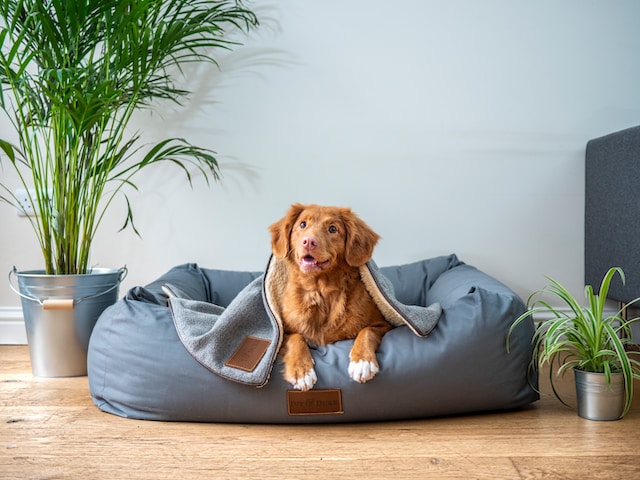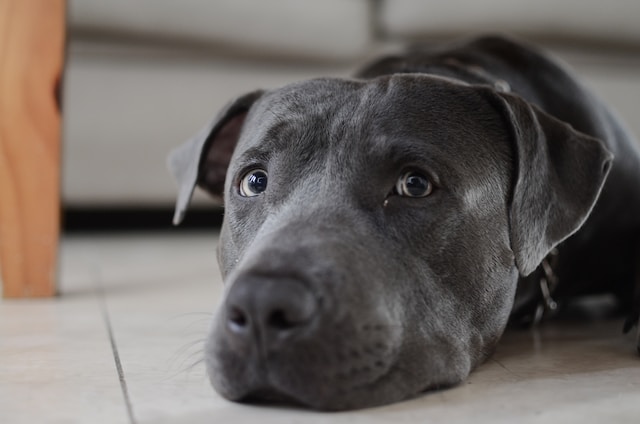As a responsible pet owner, ensuring the safety and well-being of your furry companion is a top priority, especially during the night when you may not be able to actively supervise them.
Confining your dog to one room at night can be a practical solution to provide them with a secure and comfortable space, while also aiding in training and behavior management.
In this article, we will explore in detail the considerations and steps involved in confining a dog to one room at night, along with tips for addressing potential challenges and promoting your dog’s health and happiness.
Why Confining a Dog to One Room at Night?
Behavior Management: Confining your dog to one room at night can be an effective way to manage their behavior. For example, if your dog has destructive tendencies, such as chewing on furniture or belongings, or if they are prone to house soiling, confining them to a designated room can prevent them from causing damage to your home while you sleep.
Safe Space Provision: Some dogs may feel more secure and comfortable in a smaller space, especially if they are used to being crate-trained or if they have anxiety or fear-related issues. Confining them to one room can provide them with a safe space where they can feel secure and relaxed during the night.
Accommodation of Special Circumstances: There may be situations where you need to confine your dog to one room at night due to special circumstances. For example, if you have guests with allergies, a designated room can provide a pet-free environment. Similarly, if you are staying in a hotel or a temporary accommodation that restricts your dog’s access, confining them to one room can be a temporary solution.
Creating a Confinement Plan for Your Dog

Evaluate Your Dog’s Needs: Before confining your dog to one room at night, it’s essential to evaluate their individual needs.
Consider factors such as your dog’s age, size, breed, health condition, behavior, and temperament. This will help you determine if confining your dog to one room is appropriate and how to set up the room to meet their needs.
Choose a Suitable Room: Select a room that is safe, comfortable, and appropriate for confining your dog at night. Ideally, the room should have a door that can be securely closed, windows for natural light, and proper ventilation to ensure adequate airflow.
Avoid rooms with hazards such as exposed cords, toxic substances, or furniture that can pose a risk to your dog’s safety.
Prepare the Room: Before confining your dog to the designated room, prepare it to make it comfortable for them. Provide a cozy and clean space for your dog to rest, with a comfortable bed, fresh water, and familiar items such as their toys or blankets.
You may also consider using calming aids, such as pheromone diffusers or white noise machines, to help your dog relax during the night.
Gradual Introduction: Introduce the confinement routine gradually to help your dog adjust to the new arrangement. Start by spending time in the room with your dog during the day, so they associate the room with positive experiences.
Encourage your dog to enter the room willingly and reward them with treats and praise. Avoid forcing your dog into the room or using punishment, as this can create negative associations and increase anxiety.
Positive Reinforcement: Use positive reinforcement techniques to encourage your dog to view the confinement as a positive experience. Reward your dog with treats, praise, and attention when they willingly enter and stay in the designated room.
You can also provide engaging toys, puzzle feeders, or interactive games to mentally stimulate your dog during their time in the room.
Stick to a Routine: Establish a consistent routine for confining your dog to one room at night. Dogs thrive on routine, and having a consistent schedule can help them feel more secure and comfortable.
Set a specific bedtime routine that includes taking your dog for a bathroom break, providing them with food and water, and spending some quality time with them before leaving them in the designated room for the night.
Consistency in the routine will help your dog understand what is expected of them and minimize anxiety or confusion.
Monitor Your Dog: It’s important to monitor your dog during the confinement period to ensure their safety and well-being. Regularly check on your dog to make sure they have enough water, a clean and comfortable sleeping area, and are not showing signs of distress or discomfort. If you notice any changes in your dog’s behavior or health, consult with your veterinarian for proper guidance and adjustments to the confinement plan.
Provide Mental and Physical Stimulation: Even though your dog may be confined to one room at night, it’s crucial to provide them with mental and physical stimulation during their awake hours.
Take your dog for regular walks, engage them in interactive play, and provide them with toys, puzzles, or treat-dispensing toys to keep their mind and body active. Mental and physical stimulation can help prevent boredom and reduce stress or anxiety in confined dogs.
Consider Professional Help: If you are struggling with confining your dog to one room at night, or if your dog is showing signs of severe anxiety or distress, consider seeking professional help from a qualified dog trainer or a veterinary behaviorist.
They can provide you with guidance, training techniques, and behavior modification plans tailored to your dog’s needs and help you make the confinement experience more positive and successful for your dog.
Steps involved in confining a dog to one room at night

Selecting the Appropriate Room: Choosing the right room for confining your dog at night is crucial. Consider the size of the room, accessibility, and temperature.
Ideally, the room should be spacious enough for your dog to move around comfortably, with proper ventilation and lighting. It should also be a room that is easily accessible for you to check on your dog and provide the necessary care.
Preparing the Room: Once you have selected the room, it’s important to set up a comfortable sleeping area for your dog. Depending on your dog’s preferences and needs, you can choose a suitable bed, crate, or mat.
Provide soft bedding that is appropriate for your dog’s size and breed, and consider adding some familiar toys or blankets to make the space feel cozy and familiar to them. Also, make sure to provide access to clean water for your dog’s hydration needs.
Establishing a Routine: Consistency is key when confining your dog to one room at night. Establishing a routine can help your dog adjust to the confinement and feel more secure.
Create a consistent bedtime routine that includes activities such as feeding, exercise, and potty breaks before confining your dog to the designated room. This will help your dog associate the routine with bedtime and settle down for the night.
Introducing the Confinement: Introduce your dog to the confined space gradually to prevent stress or anxiety. Start by allowing your dog to explore and get used to the room while supervised.
Use positive reinforcement and rewards, such as treats or praise, to encourage your dog to enter and stay in the room willingly. Avoid using punishment or negative reinforcement, as it may cause fear or aggression in your dog.
Managing Potential Challenges to confining a dog to one room at night
When it comes to confining a dog to one room at night, there are potential challenges that pet owners may face. These challenges can vary depending on the individual dog and the specific circumstances. Here are some potential challenges to be aware of:
Anxiety and Stress: Dogs are social animals and may experience anxiety or stress when confined to a single room, especially if they are used to having more freedom to move around. Separation anxiety or confinement anxiety may arise, leading to behaviors such as whining, barking, scratching, or destructive chewing.
Boredom and Lack of Stimulation: Dogs need mental and physical stimulation to thrive. Confining a dog to one room at night may limit their opportunities for exercise, play, and exploration, which can result in boredom and frustration. This can manifest in behaviors such as excessive barking, digging, or pacing.
House Soiling and Accidents: Dogs typically need to relieve themselves regularly, and confining them to one room may make it challenging for them to access a designated bathroom area. This can result in house soiling accidents, which can be frustrating for both the dog and the owner to clean up.
Escaping or Breaking Out: Some dogs may try to escape from the confined room by scratching or digging at doors, windows, or walls. This can result in damage to property and potential injuries to the dog.
Health and Hygiene Concerns: Confining a dog to one room may limit their access to water, which can lead to dehydration. Additionally, if the room is not properly ventilated or cleaned, it can result in poor air quality, unpleasant odors, and potential health risks for both the dog and the owner.
Adjustment Period: Dogs may need time to adjust to being confined to one room, especially if it’s a new routine or environment for them. They may initially show resistance or stress-related behaviors, requiring patience and gradual acclimation.
Training and Reinforcement: Successfully confining a dog to one room at night requires consistent training and reinforcement of positive behaviors. This may require time, effort, and patience from the owner to establish and maintain a routine.
Compatibility with Dog’s Needs: Confining a dog to one room may not be suitable for all dogs, as some may have specific needs or medical conditions that require more space or access to different areas. It’s important to consider the individual needs and temperament of your dog when implementing a confinement routine.
Final thoughts
In conclusion, confining your dog to one room at night can be a practical solution for various reasons, such as managing their behavior, providing a safe space, or addressing specific needs.
However, it’s essential to consider the potential challenges that may arise and take appropriate measures to mitigate them.
Addressing issues such as anxiety, boredom, house soiling, escaping, health and hygiene concerns, adjustment period, training, and compatibility with your dog’s needs are crucial for creating a positive confinement experience.
Consulting with a professional and prioritizing your dog’s well-being, comfort, and safety should always be the top priority.
With proper planning, training, and monitoring, confining your dog to one room at night can be a successful strategy in creating a safe and secure environment for your furry friend.







